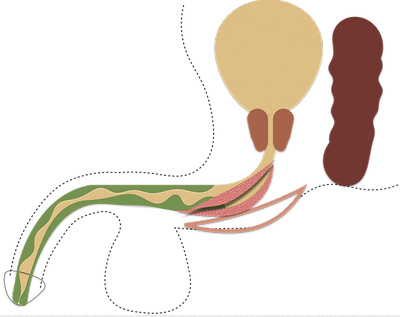Panurethral Stricture
Panurethral stricture surgery (strictures that span the whole length of the urethra)
An x-ray known as a urethrogram involves squirting dye into the urethra to see where the stricture is located. This x-ray and the accompanying illustration show the appearance of stricture that spans almost the entire length of the urethra. It is tightest at the tip.
There are three main options for treatment that are described below:
-
Meatotomy and self dilation
-
Perineal urethrostomy
-
Urethroplasty

perineum
front
bladder
rectum
prostate
back

front
perineum
Meatotomy and self-dilation
In a meatotomy, the skin on the tip of the underside of the head of the penis is cut (dashed red line). This cut is depended to open the urethra too. The cut is continued in the direction of the shaft of the penis until the worst part of the scar tissue has been opened up. This leads to an extended urethral opening on underside of the penis — it is not a new hole for peeing through, it is a longer hold for peeing through. With such a long scar tissue, this extended opening won’t completely treat the scar tissue, just the worst of it. To keep the rest of the urethra open, the patient will pass a catheter himself through the urethra every other day to dilate the urethra along the whole length of the scar. Results may be better if this catheter is coated with a steroid ointment which helps block scar tissue re-formation.
Perineal Urethrostomy
A perineal urethrostomy can simply be thought of as a pee-hole in the perineum (behind the scrotum). The skin in the perineum is opened.

front
perineum
back
prostate
bladder
rectum

front
perineum
back
prostate
bladder
rectum
The urethra is cut open through the healthy section behind all of the scar.

front
perineum
back
prostate
bladder
rectum
The edges of the open urethra are sewn to the edges of the open skin.
The skin is sewn to the edges of the urethra so that the urine now passes from the bladder, out the prostate and through the new urethral opening (perineal urethrostomy). We don’t close off the rest of the urethra to the penis, so there is nothing preventing you from peeing out the normal way through the penis except that the stricture means the path of least resistance will be out the new hole.
You have normal control over when you pee and you should not leak urine with this new hole. This is because the sphincter muscle that helps you hold your urine inside is located in the prostate which is upstream of the new hole.
If you ejaculate during sex or masturbation then the semen will come out this new hole too.

front
perineum
back
prostate
bladder
rectum
Urethroplasty for Long-Segment Stricture

front
perineum
back
prostate
bladder
rectum
Urethroplasty using two buccal mucosa grafts:
After making a skin incision in the penis and the perineum (area behind scrotum), the urethra is opened lengthwise along the entire length of the scar tissue.

front
perineum
back
prostate
bladder
rectum
A skin graft is taken from mouth from the inside of both cheeks. Each one is about 2cm wide and 7cm long. These are connected end-to-end and then patched on to the opened up urethra. This expands the diameter of the urethra.
Advantages:
-
70% chance of not needing any more surgeries or dilations
-
pee from the tip of the the penis
Disadvantages:
-
Long operation (5 hours)
-
Discomfort of graft harvest from cheeks
-
Chance of penile curvature with erections (10%)

front
perineum
back
prostate
bladder
rectum
7 cm
2 cm
